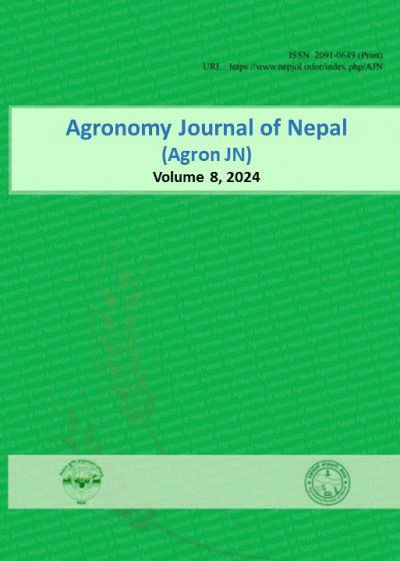Assessment of Soil Fertility Status in Vegetable Growing Area of Daman-Palung, Nepal
DOI:
https://doi.org/10.3126/ajn.v8i1.70764Keywords:
Soil test, soil fertility, Daman, PalungAbstract
Soil fertility assessment is essential for sustainable planning for a particular area. Considering this, a study was conducted in November 2018, to determine the soil fertility status of the vegetable growing area of Makwanpur district, Nepal. In total, 50 soil samples were collected randomly from a depth of 0-20 cm using a soil sampling auger. A standard analytical method was used to analyze the texture, soil pH, (Organic matter (OM), Nitrogen (N), Phosphorus (P2O5), and Potassium (K2O) status of samples at the National Soil Science Research Centre, Khumaltar. The sand, silt and clay content were 45.67±2.08, 35.6±51.37 and 18.49±0.93 respectively and were indicated as loam and sandy loam in texture. The soil was moderately acidic (pH 5.11±0.5) in nature. Soil organic matter ranged from low to medium but the medium (3.37±1.72 %) was prevalent. Total nitrogen content (0.22±0.01 %) and available phosphorus (230.58 ±85.61 ppm), were found to be high. Furthermore, available potassium (97.4±70.04 ppm) content was medium in the soil. The purpose of this soil fertility assessment is to help researchers and farmers in Daman, Palung know the soil fertility status of their area and to guide sustainable soil fertility practices. This soil fertility assessment aims to help researchers and farmers in Daman, Palung understand soil fertility status and determine the best soil fertility practices for their area.
Downloads
Downloads
Published
How to Cite
Issue
Section
License
Copyright (c) 2024 Agronomy Society of Nepal (ASoN)

This work is licensed under a Creative Commons Attribution-NonCommercial 4.0 International License.
ASON permits for free use, distribution and reproduction in any medium if the original work is properly cited and not used for commercial purposes.




